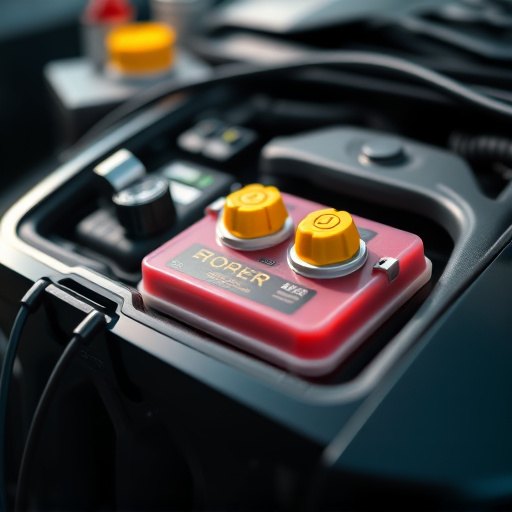Knowing when to replace your car battery (typically 3-5 years) is crucial for avoiding breakdowns. Signs like slow starts or dim headlights indicate a need for replacement, along with corroded terminals that can damage internal components. Even if not at the end of its life, performance issues may require a new battery for optimal vehicle operation. To replace it safely and efficiently, gather essential tools including insulated gloves, a voltage tester, ladder, wrenches/sockets, cable kit, new battery tray, hold-down clamps, screwdriver, and wire strippers. Follow these steps: park on a level surface, engage the parking brake, remove old clamps, strip connections, lift out the old battery, install the new one, reconnect positive then negative clamps, and verify clean, non-corrosive connections.
In today’s world, knowing how to replace your car battery is an essential skill. Whether it’s due to age, corrosion, or a sudden failure, understanding when and how to replace it can save you from costly towing fees and inconvenient breakdowns. This guide will walk you through the process, highlighting the top 7 tools needed for a safe and efficient replacement. From voltage testers to wrench sets, these tools are your allies in ensuring a smooth and successful car battery replacement.
- Understanding When to Replace Your Car Battery
- Top 7 Tools for Efficient and Safe Car Battery Replacement
- Step-by-Step Guide: How to Replace Your Car Battery Using the Right Tools
Understanding When to Replace Your Car Battery

Knowing when to replace your car battery is crucial for keeping your vehicle running smoothly. While a dead battery can be a sudden and frustrating experience, regular maintenance can prevent such crises. A battery typically lasts between 3 to 5 years, depending on usage, climate, and quality; however, if you notice signs like a slow engine start, dim headlights, or frequent dead batteries, it might be time for a replacement.
Keep an eye out for corroded battery terminals, which can inhibit the flow of electricity. If left unattended, corrosion can damage internal components and lead to premature failure. Additionally, consider the age and overall health of your battery; even if it hasn’t reached the typical lifespan, performance issues could indicate a need for a new one. Regular checks and timely replacements ensure optimal vehicle performance and avoid inconvenient breakdowns.
Top 7 Tools for Efficient and Safe Car Battery Replacement

When it comes to replacing your car’s battery, having the right tools can make all the difference in ensuring a safe and efficient process. Here are the top 7 tools that every car owner should have on hand for this task.
First and foremost, you’ll need a set of high-quality, insulated gloves and safety glasses. These protective gear items are essential to prevent any accidental contact with battery acid and ensure your safety during the replacement process. Next, invest in a reliable voltage tester to check if the battery is indeed dead and to test the new one after installation. A sturdy step ladder is also crucial for reaching the battery safely, especially in higher vehicles. Additionally, a pair of adjustable wrenches or socket sets will come in handy for loosening and tightening terminal bolts. For a clean and efficient replacement, consider getting an electric cable kit with positive and negative clamps to reconnect your vehicle’s electrical system without any hassle. A new battery tray and hold-down clamps are also necessary to ensure the secure placement of the new battery. Lastly, don’t forget a set of basic tools like a screwdriver and wire strippers for any additional tasks that may arise during the replacement process.
Step-by-Step Guide: How to Replace Your Car Battery Using the Right Tools

Replacing your car battery is a crucial task that every driver should know how to do. With the right tools, it’s a straightforward process that can save you from being stranded on the side of the road. Here’s a step-by-step guide to help you through the replacement process, ensuring everything is done safely and efficiently.
First, gather your tools for car battery replacement, including a new battery of the correct voltage and size, a socket wrench or ratchet set, safety goggles, gloves, and wire strippers. Park your car on a level surface and engage the parking brake. Turn off all electrical devices and ensure the ignition is in the “Off” position. Put on your protective gear for safety. Remove the old battery by loosening the negative (- ) terminal clamp first, followed by the positive (+) one. Use the wire strippers to carefully remove any corroded connections. Once the clamps are off, lift the old battery out of the tray. Install the new battery in the same position, ensuring it’s secure and aligned correctly. Reconnect the positive terminal first, followed by the negative one, tightening the clamps firmly but not excessively. Verify that all connections are clean and free from corrosion.
When it comes to replacing your car battery, having the right tools makes the process efficient and safe. By understanding when a replacement is necessary and utilizing these seven best tools, you can confidently tackle this common car maintenance task. Remember, a well-maintained battery ensures your vehicle starts smoothly and reliably, keeping you and the road ahead safe.
